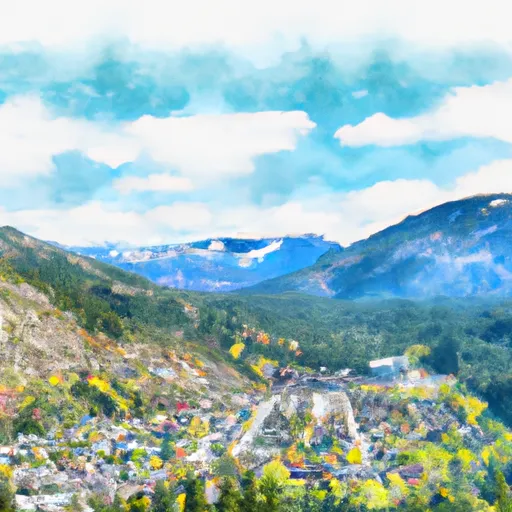-
 Snoflo Premium
Snoflo Premium
Get unlimited access to all our content
With no Ad interruptions! - Start Your Free Trial Login with existing account
White-Pass
Eden Index
Climate
8.0
•
Recreation
2.3
•
Community
•
Safeguard
4.0/10

White Pass is a picturesque mountain pass located in the state of Washington, USA. Situated in the Cascade Range, it offers stunning views and an array of outdoor recreational opportunities. The climate of White Pass is characterized by mild summers and snowy winters. Summers are generally warm and pleasant, with temperatures averaging around 70°F (21°C). Winters, on the other hand, bring heavy snowfall, transforming the pass into a winter wonderland, ideal for skiing and snowboarding.
Hydrologically, White Pass is fed by the surrounding mountains and receives ample precipitation, both as rain and snow. This contributes to the formation of numerous creeks and streams that flow through the region, offering picturesque sights and opportunities for fishing and water-based activities.
Outdoor enthusiasts flock to White Pass throughout the year for its myriad recreational activities. During summer, visitors can indulge in hiking, camping, mountain biking, and wildlife viewing. The pass is home to a variety of trails that cater to all skill levels, showcasing the natural beauty of the surrounding wilderness. In winter, White Pass becomes a haven for snow sports enthusiasts, with its excellent ski slopes and snow-covered landscapes.
In conclusion, White Pass, Washington, offers a diverse climate with mild summers and snowy winters. Its hydrology constituents include various creeks and streams, providing opportunities for fishing and water-based activities. With its abundance of outdoor recreation opportunities, including hiking, camping, mountain biking, and skiing, White Pass is a true paradise for nature lovers and adventure seekers.
What is the Eden Index?
The Snoflo Eden Index serves as a comprehensive rating system for regions, evaluating their desirability through a holistic assessment of climate health, outdoor recreation opportunities, and natural disaster risk, acknowledging the profound impact of these factors on livability and well-being.
Climate Health Indicator (CHI): 8.0
White-Pass receives approximately
700mm of rain per year,
with humidity levels near 72%
and air temperatures averaging around
6°C.
White-Pass has a plant hardyness factor of
6, meaning
plants and agriculture in this region thrive during a short period during spring and early summer. Most
plants will die off during the colder winter months.
By considering the ideal temperature range, reliable water supplies, clean air, and stable seasonal rain or snowpacks, the Climate Health Indicator (CHI) underscores the significance of a healthy climate as the foundation for quality living.
A healthy climate is paramount for ensuring a high quality of life and livability in a region, fostering both physical well-being and environmental harmony. This can be characterized by ideal temperatures, reliable access to water supplies, clean air, and consistent seasonal rain or snowpacks.
Weather Forecast
Streamflow Conditions
Yakima
Area Rivers
Yakima
Snowpack Depths
Yakima
Reservoir Storage Capacity
Yakima
Groundwater Levels
Recreational Opportunity Index (ROI): 2.3
The Recreational Opportunity Index (ROI) recognizes the value of outdoor recreational options, such as parks, hiking trails, camping sites, and fishing spots, while acknowledging that climate plays a pivotal role in ensuring the comfort and consistency of these experiences.
Access to outdoor recreational opportunities, encompassing activities such as parks, hiking, camping, and fishing, is crucial for overall well-being, and the climate plays a pivotal role in enabling and enhancing these experiences, ensuring that individuals can engage in nature-based activities comfortably and consistently.
Camping Areas
| Campground | Campsites | Reservations | Toilets | Showers | Elevation |
|---|---|---|---|---|---|
| Little Naches | 24 | 2,562 ft | |||
| Crow Creek | 15 | 2,723 ft | |||
| Tree Phones- State Forest | 14 | 4,828 ft | |||
| Manastash Camp | 30 | 5,064 ft | |||
| Icewater Creek | 15 | 2,704 ft | |||
| Hause Creek | 42 | 2,555 ft | |||
| Kaner Flat | 55 | 2,697 ft | |||
| Ahtanum Camp - State Forest | 6 | 3,097 ft | |||
| American Forks | 23 | 2,741 ft | |||
| Clover Flats- State Forest | 9 | 6,302 ft |
Nearby Ski Areas
Catastrophe Safeguard Index (CSI):
The Catastrophe Safeguard Index (CSI) recognizes that natural disaster risk, encompassing floods, fires, hurricanes, and tornadoes, can drastically affect safety and the overall appeal of an area.
The level of natural disaster risk in a region significantly affects safety and the overall livability, with climate change amplifying these risks by potentially increasing the frequency and intensity of events like floods, fires, hurricanes, and tornadoes, thereby posing substantial challenges to community resilience and well-being.
Community Resilience Indicator (CRI):
The Community Resilience Indicator (CRI) recognizes that education, healthcare, and socioeconomics are crucial to the well-being of a region. The CRI acknowledges the profound impact of these elements on residents' overall quality of life. By evaluating educational resources, healthcare accessibility, and economic inclusivity, the index captures the essential aspects that contribute to a thriving community, fostering resident satisfaction, equity, and social cohesion.

